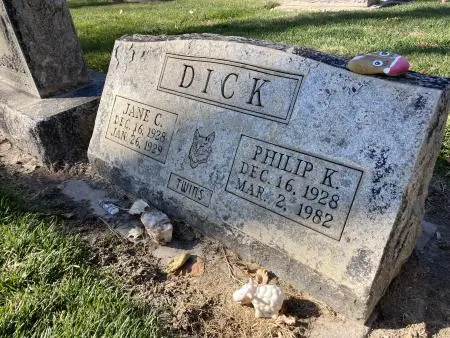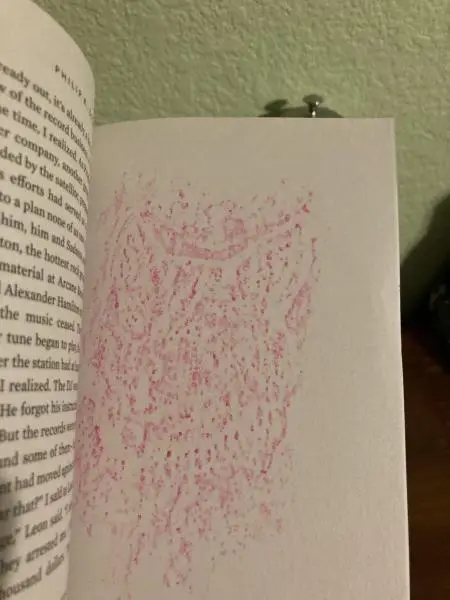Photos by Peter Derk
Philip K. Dick’s stories built worlds where time reversed and people had to be unburied before they suffocated, worlds where people used a store-bought spray product to fix breaks in the fabric of reality, worlds where space travelers competed to bring the best hallucinogens to humanity.
The story of Philip K. Dick’s grave also built more than one world, more than one story about how things wound up the way they are.
By the way, I wouldn’t normally start a column, a story, or anything with a name. But for the name Philip K. Dick, I make exceptions, and I won’t apologize.
The Grave
Let’s start with today, with the one detail that’s literally set in stone. The one detail I’ve touched.
This is what Philip K. Dick’s grave looks like today.

This grave is the jumpoff point for our trips into separate, parallel story worlds, worlds where Philip’s parents gambled on his survival, where Philip died and his twin sister lived, and even a world with burial before death.
The Tragic Deaths of Jane
Here’s one story, the one that just about everyone agrees on:
Jane and Philip were fraternal twins who came a good six weeks early. For those of you who haven’t quite finished What to Expect When You’re Expecting, those last six weeks of bake time are important for babies. Especially their brains, lungs, and fat.
Philip was about 4.5 pounds when he was born, Jane a pound lighter. I know those numbers don’t mean a lot, so the story goes that the babies were so small that their mother, Dorothy, tucked them both into a shoebox, which was set on top of the oven as a sort of incubator.
Dorothy wrote Philip an apologetic letter about the twins' chaotic first weeks at home:
For the first six weeks of your life, you were both starving to death because the (incompetent) doctor I had could not find the right formula for your food and because I was so ignorant I didn’t know how desperate your condition was. I did know that things weren’t right, but I didn’t know how to get other help.
Here’s where the story splits.
One story goes that Dorothy discovered a $50 per child health insurance policy for the kids, and the Dicks were on the way to the hospital when Jane died, but Philip survived.
The other story goes that a MetLife agent happened to stop by the house, and the Dicks got a $50 per child life insurance policy for their babies. Meaning they may not have wanted their babies to die, but they did put money on it. The policy came with a nurse’s visit, which probably saved Philip’s life, but it was too late for Jane, who was more underweight and had also been badly burned by a hot water bottle Dorothy was using to keep the babies warm.
The way one story is told, the storytellers take the Dick parents to task. They say Dorothy was careless and Joseph, their father, was mostly absent. They say that gambling on your kids dying is pretty cold.
The other story, told by people who are more charitable, says the Dicks kept their babies away from the hospital because they were poor. That they did their best.
Both stories end in the same place. It's just a matter of whether or not it matters how we get there.
Two Janes
Twins Philip K. Dick and Jane C. Dick are buried in Fort Morgan, Colorado, a town you’ve never heard of.
Fort Morgan is real Colorado to me, but a different storyteller would see another world in Fort Morgan, a couple buildings out on the plains where nobody’d really want to live.
The story of why Philip is buried there is tied up in the story of why Jane is buried there.
One story goes, after Jane died, she was shipped to Fort Morgan where her fraternal grandparents were living. For this version of the story, I have to speculate why Jane was sent there. Maybe the Dicks, who were on the verge of moving from Chicago to San Francisco, didn’t want Jane buried alone in Chicago, and perhaps they didn’t know what the situation would look like in San Francisco, so they went with a stable option, a very literal version of meeting half-way. At least Jane would be buried next to her grandparents when they eventually passed instead of being left entirely alone in a city with no family.
The other story that ends in Fort Morgan goes like this: the twins were born, and the Dicks began their trip cross-country not too long after, even though the twins were not healthy. Jane either died on the trip or was in bad health by the time they hit Fort Morgan, a likely planned stop with family.
Jane’s death, listed in the Death And Stillbirth Index, tells one story, that Jane died in Cook County, IL, on January 20th, and that she was buried on the 25th.
Jane’s headstone tells a different story, saying she died on January 26th.
In one story, one world, she lived an extra six days. In another, she lost those days, but she died at home.
The stories converge again here, with Philip's death. Philips father, Joseph, outlived Philip by a few years, and it was his choice to reunite Philip’s remains with Jane’s. Philip, Jane, their father, and their fraternal grandparents all share a resting place in Fort Morgan, CO.
Another Hole in the Universe
There is another divergence in the story of Philip’s grave.
One story, the romantic story, goes that Jane was buried, and her and Philip’s headstone was set in the earth in Fort Morgan, Jane’s name and death date on one side, Philip’s name on the other, a blank spot just waiting for the inevitable date. In this story world, Philip spent his entire life knowing that blank spot on the gravestone waited for him. Philip K. Dick's Wikipedia page confirms this story world:
[Philip was] buried next to his twin sister Jane, who died in infancy. Her tombstone had been inscribed with both of their names at the time of her death, 53 years earlier.
The other story is one I got from the cemetery superintendant via email. I’d asked about Philip's headstone because it appeared newer than other stones from the late 20’s. Here’s what he said:
...so the stone at Philip’s gravesite was placed after he passed away… until then there was only a temporary marker for his baby sister, a very common marker to be left in our Cemeteries.
In this story, maybe there never was a stone with Philip’s name on it. Maybe the idea that haunted him was, like so many others, one that Philip invented.
Jane’s Final, Real Death
Philip thought of Jane often, sometimes as a story, sometimes as a lot of different stories.
In one story Philip concocted, he was dead, buried somewhere on the Colorado plains, and Jane was alive.
In another story, published as The Exegesis of Philip K. Dick, Philip describes a series of visions he had and possible reasons they came to him. One story Philip used to explain the visions was that they were Jane contacting him from beyond the(ir) grave. In another one of these visions, Philip saw a savior named Tagore who is covered in burns, harkening back to baby Jane’s burned legs.
In some of these stories, Philip blamed himself for Jane's death.
Another story goes that Philip considered most of his writing to be re-enactments of his time with Jane, parental neglect and his fortunate recovery:
...the ultimate problem confronting me all my life has been the senseless injury to and neglect of my sister.
Whatever Jane’s story was, it was bigger than the story of a baby who died only weeks after her birth.
In The Bomber Mafia, Malcolm Gladwell puts it like this:
The psychologist Daniel Wegner has this beautiful concept called transactive memory, which is the observation that we don’t just store information in our minds or in specific places. We also store memories and understanding in the minds of the people we love. You don’t need to remember your child’s emotional relationship to her teacher because you know your wife will; you don’t have to remember how to work the remote because you know your daughter will. That’s transactive memory. Little bits of ourselves reside in other people’s minds. Wegner has a heartbreaking riff about what one member of a couple will often say when the other one dies—that some part of him or her died along with the partner. That, Wegner says, is literally true. When your partner dies, everything that you have stored in that person’s brain is gone.
Of all the places, all the worlds, the one that devoted the most to Jane was the world inside the mind of Philip K. Dick.
And with Philip's death, that space died, too. Jane died, too.
Grave Matters
Here’s the story I tell about Philip K. Dick’s grave. The one that goes the way I like.
Philip and Jane were born in Chicago, and Jane didn’t make it long in her small, burned body. But what remained of her, whether that was all contained in Philip or a real force somewhere in the universe, brought us stories. Whether Philip was inspired to tell Jane’s story over and over, or whether Philip didn’t have a choice and was trapped in an endless loop of re-living their shared tragedy, the end results are hard to argue with.
Philip and Jane’s grave has inspired stories, too. Stories that can’t all be reconciled with each other. Instead, we have to look at them as stories from parallel Earths, all true and untrue at the same time. We have to accept that reality might not ever be one certain, exact thing.
I think Philip would like that.
Thanks for taking this trip with me. For your patience and readership, I have a reward:

I took a copy of Radio Free Albemuth to Philip K. Dick’s grave, and I did a rubbing of the cat image from the headstone’s center. It’s not perfect, it’s not even pretty, and in fact the one pictured here is a second attempt (there's another, uglier rubbing in the book's front), but it's real, it touched the stone, and I’ll send it to one reader, totally free. All you have to do is comment here, say whatever you’d like, whether it be “RIP PHIL” or “#RememberJane.” Whatever the comment, that’s your entry. I’ll pick a random winner, and I’ll send the book your way. You've got a week from the initial publication of this column to enter.
Get The Exegesis of Philip K. Dick by Philip K. Dick at Bookshop or Amazon
Get Radio Free Albemuth by Philip K. Dick at Bookshop or Amazon

About the author
Peter Derk lives, writes, and works in Colorado. Buy him a drink and he'll talk books all day. Buy him two and he'll be happy to tell you about the horrors of being responsible for a public restroom.







